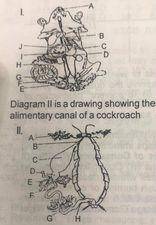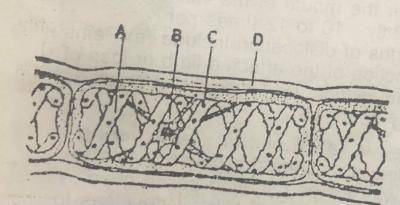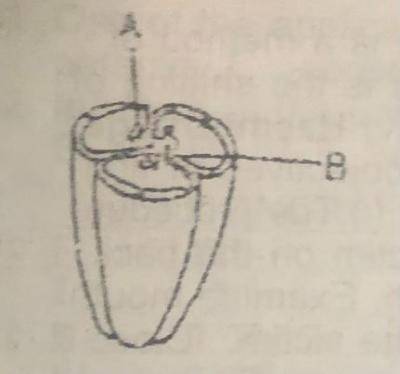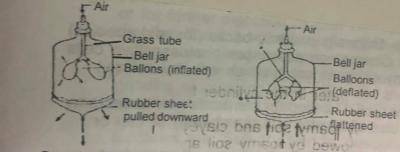In the following experiments wash the test tube and the measuring cylinder before each use. You are provided with Solution A (a) Place three drops of solution A on a white tile and add one drop of iodine solution. Record your observation (b) Put 10cm³ of solution A in a beaker and add a few drops of dilute tetraoxosulphate (vi) acid (H\(_2\)SO\(_4\),) in a test tube and boil fora few minutes. Then add a few drops of sodium hydroxide solution and allów the mixture to cool. Divide the mixture into two equal portions

Diagram 1 is a drawing showing the alimentary canal of a mammal. Study the diagram carefully (a) Name the structure labelled A to J (b) What are the functions of the parts labelled A, C and H?
(C) Name the parts labelled A to H (d) State the functions of the parts labelled D and E (e) State two features common diagram I and D in diagram II (f) identify and name the parts in diagrams I and ll that perform similar functions
(a) identify specimens A and B (b) (i) Name the group or class of animals to which each specimen belongs (ii) State the location of specimen B in the organism (c) State two characteristic features common to specimens A and Band which adapt them to their functions (d) What is the function of specimen A in the organism? (e) Suggest the habitats of the animals to which each of the specimens belongs (f) Make a labelled drawing 6 to 7cm long of specimen B to illustrate its essential features.

Study the diagram below (a) (i) ldentify the organism illustrated in the diagram (i) Give two reasons for your answer
(b) (i) Name the parts labelled A to D (ii) State the function of one of the labelled parts
State two ways in which agricultural practices can affect an ecological system.
Give one example each of (a) protective colouration (b) structural adaptation in animals for temperature regulation 4.

The diagram below represents the transverse section of a fruit (a) State the kind of placentation found in the fruit (b) Name one fruit that has this kind of placentation

(a) Name the parts labelled A, B, C and D
(b) What is the significance of the relative size of B and C?
(c) Name the structures in: (i) Amoeba (ii) earthworm. Which are equivalent in function to the structure illustrated in the diagram

The set-up in diagrams I and II illustrate breathing mechanisms in mammals
(a) Name the structures in mammals that are equivalent in function to the parts labelled (i) glass tube (ii) bell jar (iii) balloons (iv) rubber sheets (v)A (vi) B.
(b) Name the processes illustrated by diagrams (i) I (i)
(c) In which of the bell jars is the pressure lower?
(a) What is conservation of natural resources?
(b) List various natural resources that need to be conserved. State briefly the benefits of conservation in each case.
(c) List the problems often encountered in ensuring conservation of natural resources.
(d) What are the efforts being employed in your country to ensure conservation of natural resources?
(a) (i) Define the term population. (ii) List two biotic and abiotic factors each that affect population growth.
(b) What are the effects of food shortage on a population?
(c) Describe two methods each for:
(i) improving crop yield (ii) preserving and storing food. Explain the principle involved in each of the methods described.
(a) State four modes of nutrition in plants.
(b) Outline the process involved in the light and dark reactions of photosynthesis.
(c) Describe briefly the modifications and the mechanisms associated with the following feeding habits:
(i) filter feeding in mosquito larva; (ii) parasitic feeding in tapeworm.
(i) Make a labelled drawing of a typical plant cell to show its essential features.
(ii) Give the functions of two labelled organelles
(b) Describe briefly two levels of cell organization in living organisms giving an example of each type.
(c) What role do the following processes play in the activities of a living cell (i) osmosis; (ii) diffusion.
Which of the following has the most primitive respiratory system?
- A. Rat
- B. Fish
- C. Toad
- D. Grasshopper
- E. Lizard

The rate of transportation will be highest In
- A. I
- B. II
- C. III
- D. IV
- E. V

The plants best adapted for life in the desert are
- A. I and IV only
- B. II and IV only
- C. Ill and IV only
- D. lV and V only
- E. I Il Ill and V
Which of the following is not true about gene mutation? It
- A. introduces new traits into a population
- B. causes changes in the DNA
- C. may have unnoticeable effect on the phenotype
- D. always affects the chromosome number
- E. is a source of new genes
Species can be defined as the group of organisms that
- A. resemble each other and live in the same habitat
- B. are of common origin and are always found together
- C. resemble each other and can interbreed freely
- D. resemble each other and occupy the same niche
- E. are of common origin but cannot interbreed freely
The change in colour of the chameleon serves as a means of
- A. attraction to the opposite sex
- B. repulsion of the enemy
- C. a camouflage from a predator
- D. regulation of body temperature
- E. . production of a variety of skin pigments


